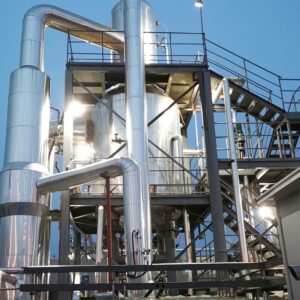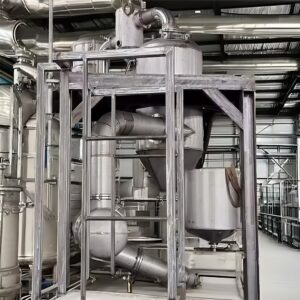The MVR (Mechanical Vapor Recompression) device compresses the secondary steam generated within the evaporation system using a compressor, increasing the steam’s enthalpy, and recirculates it for heating and evaporation. This process fully utilizes the residual heat of secondary steam and condensate within the system, resulting in significant energy savings. Without the need for fresh steam, it can save over 90% of condensate, 80% of human resources, and 60% of space.
The MVR evaporator uses a compressor to compress secondary steam. Domestic compressors can provide a temperature rise of 20°C per unit, while imported compressors offer a rise of 9°C per unit. Therefore, the evaporator system requires the feedwater to have a boiling point as much below 15°C as possible to achieve energy-efficient evaporation. In single-effect evaporation, the live steam is used only once within the system. The key difference between MVR and multi-effect evaporators is that the secondary steam is continuously recycled within the system, so its energy is not wasted. The system consumes energy only to raise the temperature from 119°C to 130°C, which is the energy consumed by the compressor. The energy-saving aspect of MVR lies in its ability to turn secondary steam from useless to useful with an input of just 16KJ (per ton of water).
Advantages of MVR Evaporator
1. High Heat Transfer Coefficient: This type of evaporator, with its variable flow field structure, allows the material liquid to easily reach a vigorous turbulent state, achieving a heat transfer coefficient 2-3 times higher than that of a tubular evaporator.
2. Low Tendency to Block: The material liquid forms a disturbed flow on the heat exchange surface, which can scour the heat exchange surface, causing scale deposits to fall off and delaying the scaling cycle.
3. Extremely Smooth Surface: The processing technology used ensures that the surface roughness of the heat exchange surface is controlled to a very low value, making it difficult for contaminants to adhere. The scaling rate of this type of heat exchanger is only 1/5 of that of tubular heat exchangers.
4. Easy to Clean and Maintain: With its plate-type structure, the heat exchange surface can be easily dismantled, and any polluted or damaged heat exchange surface can be easily replaced.
Components of MVR Evaporator
1. Preheater: In most cases, the solution to be evaporated needs to be preheated before entering the evaporator.
2. Evaporator: The solution that needs to be evaporated is heated by the steam source in the evaporator, resulting in evaporation. Different types of evaporators are chosen based on the nature of the solution.
3. Separator: Used to separate steam and liquid. Different types of separators, such as centrifugal separators, gravity separators, or specially structured separators, can be chosen based on the nature of the solution.
4. Various Pumps: Used to transport the solution to be evaporated and the concentrated solution. Different types of pumps, such as centrifugal pumps, positive displacement pumps, and screw pumps, can be chosen based on the nature of the solution.
5. Compressor: Provides the heat source for evaporation by compressing the secondary steam, thereby increasing its enthalpy. Various compressors can be chosen based on the requirements for flow rate and compression ratio, and for larger pressure increases, multi-stage compressors can be used in series.
6. Control System: The control center of the MVR evaporation system regulates motor speeds, valves, flow meters, temperature, and pressure to achieve automatic operations such as evaporation, cleaning, and shutdown. It includes automatic alarms and protection to prevent system damage and maintain dynamic balance.
7. Cleaning System: Different solutions may cause scaling after a period of evaporation. Generally, more than 99% of scaling can be removed by adding chemical solvents. CIP (Cleaning-In-Place) or dismantling cleaning can be used.





Reviews
There are no reviews yet.